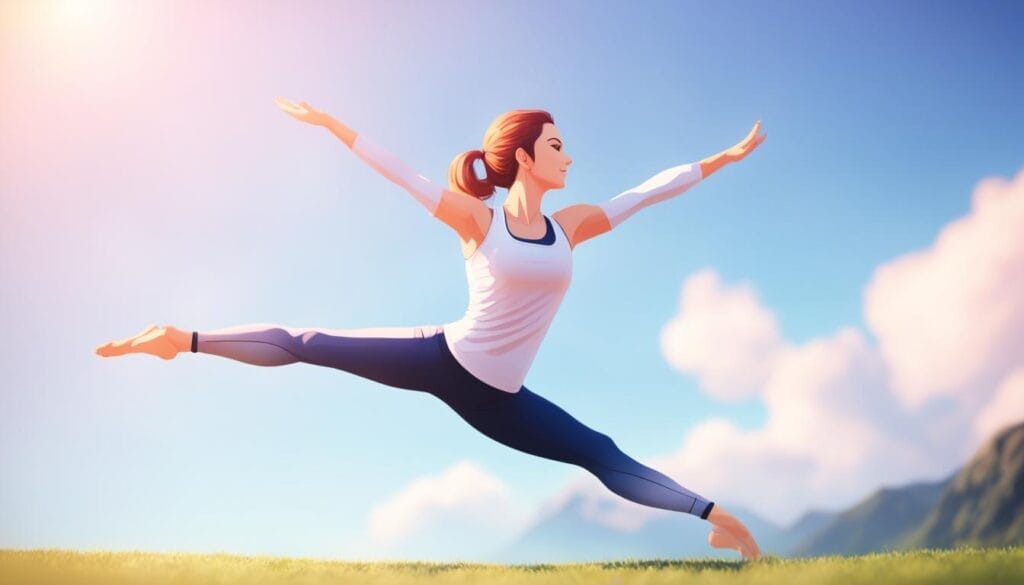Ever reached for something high up and felt your muscles pull? Or do your joints feel stiff after a long day at a desk? These times show why flexibility matters every day.
Flexibility exercises are great for health and well-being. They boost your movement range, make your joints work better, stop injuries, and make you more flexible. Doing these exercises daily can change a lot.
I want to introduce you to some great flexibility exercises. You can do them everyday. This includes gentle stretches in bed in the morning. And focused exercises for different body parts. They will improve how flexible you are and make your life better.
Key Takeaways
- Flexibility exercises play a vital role in improving range of motion and overall health.
- Regular stretching can enhance joint mobility, prevent injuries, and increase flexibility.
- Start your day with gentle morning stretches in bed to wake up your muscles.
- Include sitting and standing stretches throughout the day to maintain flexibility in different areas of your body.
- Make stretching a regular part of your routine to enjoy the long-term benefits.
Morning Stretches in Bed
Start your day the right way with morning stretches in bed. They’re gentle yet effective, waking up your muscles. This also boosts flexibility. Adding stretches to your morning can really brighten your day.
Cobra Stretch
Try the cobra stretch to start your stretching routine. Lay on your stomach with hands beneath your shoulders. Lift your upper body off the bed while keeping your lower half down. This move helps stretch your core and back, making them stronger and more flexible.
Knees-to-Chest
Knees-to-chest is another good stretch. Begin by lying on your back with legs straight. Then, pull a knee towards your chest using your hands. After holding a few seconds, switch legs. It eases tightness in your lower back and makes you feel better.
Spinal Twist
The spinal twist works wonder for your upper and lower back. Lie down with arms in a “T” shape. Cross one knee over the other, gently lowering toward the bed. Keep your shoulders down as you twist at the spine. This stretch is perfect for releasing the stress in your back and torso.
Always stretch slowly, and take deep breaths. Listen to your body, and stop if you feel pain. Doing these stretches daily enhances your flexibility. It also starts your day on the right note.
Sitting Stretches
Start your day by stretching while sitting. These moves help focus on different body areas. They also ease tightness and boost how flexible you are. Try these three stretches every day:
1. Upper Back Stretch
This stretch is great for your upper back. It eases tension between your shoulder blades and helps you sit up straight. First, sit tall in a chair. Let your feet rest flat on the floor. Now, put your hands behind your head. Your elbows should point out. Squeeze your shoulder blades together gently. Then, lean back a bit. You should feel a good stretch in your upper back. Hold for 15-30 seconds. After that, relax.
2. Neck Stretch
Next is a simple stretch to loosen up your neck. Sit straight in your chair with your shoulders relaxed. Tilt your head to one side slowly. Try to touch your ear to your shoulder. Stay like this for 15-30 seconds. You’ll feel the stretch along your neck’s side. Do the same on the other side. Finally, bring your head back to the middle.
3. Shoulder Stretch
This stretch targets your shoulder muscles. It helps make your shoulders more flexible. Start by sitting up straight. Then, stretch your right arm in front of you. Use your left hand to pull the right arm towards your chest. Feel the stretch in your shoulder. Hold it for 15-30 seconds. Then, do the same with your other arm.
Always remember to breathe deeply. Try to relax into each stretch. If anything hurts, stop and make sure you’re doing it right. These can make you more flexible and reduce tension, even during your workday.
| Stretch | Benefits |
|---|---|
| Upper Back Stretch | – Lessens tension between the shoulder blades – Betters posture |
| Neck Stretch | – Eases stiffness and tension in the neck |
| Shoulder Stretch | – Works the shoulder muscles – Enhances shoulder flexibility |

Feeling more awake? Time for some standing stretches. They’re key for making your whole body more flexible. Each stretch works on different muscles and helps you move better.
Side Stretch
This stretch is great for your obliques and the side of your body. Stand with feet hip-width apart. Lift one arm up. Lean to the side that’s not holding the arm up. You’ll feel the stretch along your torso side. Do it for 20-30 seconds. Then, switch sides and repeat.
Standing Quad Stretch
This stretch focuses on your thighs and hips flexibility. Stand straight on one leg. Grab your other foot and pull it towards your bottom. Feel the front of your thigh stretch. Hold for 20-30 seconds. Then, do the other leg.
Hamstring Stretch
Keeping your hamstrings flexible is important for the back of your legs. Stand with feet hip-width apart. Put one leg straight in front, heel on the ground. Bend forward, keeping your back straight while reaching for your toes. Hold for 20-30 seconds. Then, switch legs.
Calf Stretch
Calf muscles are crucial. So, keep them flexible. Stand near a wall with one foot ahead of the other. Hands on the wall. Lean forward slowly, keeping both heels on the ground. You’ll feel the stretch in your back calf. Hold for 20-30 seconds. Then, swap legs.
Always warm up before stretching. And do them slowly. Stop if it hurts, or ask a pro. Doing stretches right and often is how you get more flexible safely.
Adding these standing stretches can make you much more flexible. And they help you move better in daily life. Listen to your body and adjust as needed. As you get better, you can stretch more. This means you’ll be even more flexible and move greater. Keep at it, be steady, and enjoy being more flexible!
| Standing Stretches | Targeted Muscles |
|---|---|
| Side Stretch | Obliques and side body muscles |
| Standing Quad Stretch | Quadriceps and hip flexors |
| Hamstring Stretch | Hamstrings and back of the legs |
| Calf Stretch | Calf muscles |
Now, let’s add standing stretches to your routine. Do these every day or week to get more flexible. Remember to warm up and listen to your body. With time and practice, you’ll be much more flexible. Enjoy the stretching journey!
Stretching Regularly
It is vital to add regular stretching to your fitness plan. This helps keep your body flexible, lowers the chance of getting hurt, and eases any pain you may feel. Your movements will get better if you stretch often. Make sure to use both still and moving stretches to get the best effects.
Static Stretches
Static stretches are all about staying still to stretch your muscles. This way, you can boost flexibility and move your joints more easily. By taking it slow with these stretches, your muscles get time to loosen up. This helps stop injuries and makes your muscles less tight.
“Static stretches are a great way to target specific muscle groups and improve flexibility. Take your time with each stretch, holding for about 15-30 seconds while focusing on deep breathing.”
A few well-loved static stretches are:
- Hamstring stretch
- Quadriceps stretch
- Shoulder stretch
- Chest stretch
Dynamic Stretches
Dynamic stretches are the opposite. You move as you stretch, getting ready for your activity or sport. This type of stretching wakes your muscles up and makes them ready for action. It is great to do before a workout or any physical activity. It can boost your flexibility, help you perform better, and lower your injury risk.
“Dynamic stretches are a fantastic way to warm up the body before any physical activity. Incorporate movements that simulate the motions you’ll be doing during your workout or sport.”
Some dynamic stretching moves are:
- Walking lunges
- Leg swings
- Arm circles
- High knees
To get the most from stretching, do it the right way and pay attention to how your body feels. Stay away from jerky or bouncing motions. Make your stretches smooth and controlled. This should help you move better over time.

Sticking with a regular stretching routine is the real secret to success. Try to stretch daily, either before or after your workouts, or on its own. Doing so will improve your flexibility and lower injury and pain risks.
Flexibility for Different Activities
Being flexible is key but not all exercises suit everyone. Runners, athletes, or those working on hip mobility need different activities to meet their specifics. For better performance and health, aim for exercises that match your activity.
Flexibility for Runners

If you run, you know that being flexible is vital. It helps you run better and avoid getting hurt. Do exercises that stretch your legs and hips, such as lunges and calf stretches, to stay limber and run smoothly.
Flexibility for Athletes
Athletes in sports like football or tennis need to be quick and strong. For that, they should focus on flexibility in their legs. Exercises like lunges and leg swings keep them agile and help prevent injuries.
Hip Flexibility Exercises
Keeping your hips flexible is essential for avoiding hip problems. It also makes sure your lower back doesn’t ache. Try stretching your hip flexors and doing hip circles. These moves keep your hips in top shape for daily life and sports.
Flexibility Exercises for Different Activities
| Activity | Recommended Flexibility Exercises |
|---|---|
| Running | Dynamic leg stretches Hip flexor stretches Calf stretches |
| Athletics | Lunges Lateral leg swings Hamstring stretches |
| Hip Mobility | Hip circles Hip flexor stretches Butterfly stretches |
Choose exercises that fit your activity to get better and stay safe. Always check with a fitness expert or doctor to make sure you’re doing them right. They can also help you pick the best ones for you.
Benefits of Flexibility Exercises
Flexibility exercises bring loads of benefits for your health and wellness. They help boost your movement, keep you from getting hurt, and lower pain.
Getting more flexible means you can move your body more. This makes simple things easier like bending, reaching, and twisting. Regular stretches help your muscles and joints stay loose, letting you move better.
But there’s more to it. Being flexible means you might not get hurt as easily. It’s like your body can handle sudden moves without as much risk of getting a sprain or a strain.
Let’s not forget about pain. Being stiff can cause a lot of discomfort, especially if you have conditions like arthritis or backache. Stretching regularly can help ease that tightness and make moving more comfortable.
So, stretching is super important. It makes you more flexible, helps you stay safe from injuries, and keeps pain levels down. Give stretching a place in your daily routine for a healthier, happier you.

Summing Up
Adding flexibility exercises to your daily routine is crucial. It keeps you healthy and boosts your movement range. Spending time on daily stretches improves how flexible you are. This makes a big difference to both your body and mind.
You could do some easy stretches in bed when you wake up. Or maybe sit down and stretch during the day. Standing stretches are great too. Doing these regularly will really help.
Stretching does more than just make you more flexible. It also helps avoid injuries by making your joints move better. It can even lower pain from tight muscles or ongoing issues. Focusing on stretch exercises helps improve your life quality. Plus, you’ll feel freer and fitter.
So, don’t put it off any longer. Add stretching to your day now. You’ll soon see it benefits your health and movement. Life will be less about being stiff and more about being agile and well.
FAQ
Why is it important to incorporate flexibility exercises into my daily routine?
Flexibility exercises are very important for your health. They improve your range of motion and keep you more flexible. Regular exercises can make your joints move better, avoid injuries, and boost flexibility.
What are some morning stretches I can do in bed?
In the morning, you can stretch in bed with ease. Try the cobra, the knees-to-chest, and the spinal twist. These will help your muscles get ready for the day, and make you more flexible.
What are some sitting stretches I can do?
While sitting, you can stretch to feel better. The upper back stretch eases tension. The neck stretch and shoulder stretch reduce stiffness and improve shoulder flexibility.
What are some standing stretches I can do?
If you prefer standing, there are stretches for that too. Stretch your side, your quads and hamstrings, and your calves. These will make you more supple and ready for any activity.
How often should I stretch to maintain flexibility?
Stretching regularly helps keep you flexible and avoids injuries. A mix of static and dynamic stretches is recommended. This way, you increase movement, lower injury risks, and ease pain.
Are there specific flexibility exercises for different activities?
Definitely! For example, runners can benefit a lot from specific flexibility exercises. Each sport has its exercises to improve performance and stay safe. Hip exercises are also key for good hip health and to prevent problems like osteoarthritis.
What are the benefits of flexibility exercises?
Flexibility exercises do wonders for your health. They make moving easier and often more painless by improving your flexibility. This reduces injury risks and can even lower pain from conditions like arthritis.
How can I incorporate a flexibility routine into my daily life?
It’s essential to add flexibility exercises to your daily routine. They can be done in bed, sitting, or standing. This simple step can really improve your health and make you feel better every day.
Source Links
Share Me:
READY TO UNLEASH
YOUR BEST SELF?
Click “Sign Me Up!” And Start Your Fitness Transformation!





